
Advertising for Steamboats and the Trade
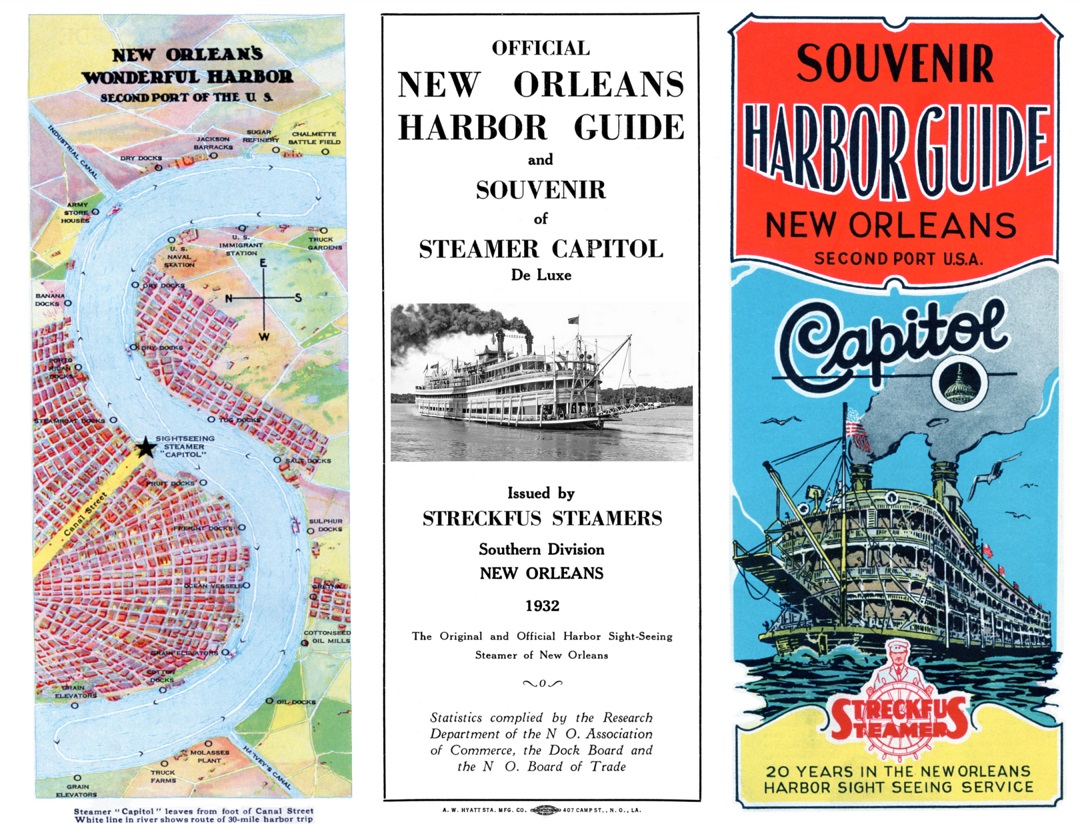
The map and the color graphic far right are on the cover, the black and white section is the title page. 72 pages all together, 4.10 x 9.00 inches. I upgraded the black and white photo of the CAPITOL.
theoldentimes.com
Advertising announcement from
The Memphis Daily Eagle and Enquirer
February 21, 1855:
REGULAR SATURDAY PACKET MEMPHIS AND NEW ORLEANS
J.O. GREENLAW . . . MASTER
The new steamer "INGOMAR" will arrive in a few days and take her place in the New Orleans trade, leaving Memphis and New Orleans on each alternate Saturday in conjunction with the H.R.W. HILL.
In fitting out this new and splendid boat, no pains and expense have been spared to make her one of the best boats on the Mississippi. For comfort and convenience of arrangement she cannot be surpassed.
Great care and attention have been given to the procuring of safe and competent officers. Shippers and the traveling public can rely upon punctuality.
LAVALLETTE & MORRIS
rogallery.com
Louis LeBreton (1818 - 1866) was a French painter who specialized in marine paintings.
Le Breton studied medicine and took part in Dumont d'Urville's second voyage aboard the ASTROLABE as a surgeon. After the official illustrator of the expedition died, Le Breton replaced him.
Beginning in 1847 Le Breton devoted himself exclusively to depicting marine subjects for the French Navy.
He travelled with Dumont d'Urville's expedition to the South Pole and Oceania from 1837 to 1840. From 1845-1847 he was part of an expedition to Madagascar. LeBreton produced tinted lithographs and chromolithographs on naval forces, ships and boats, sea landscapes and ports of call such as New Orleans, Louisiana.
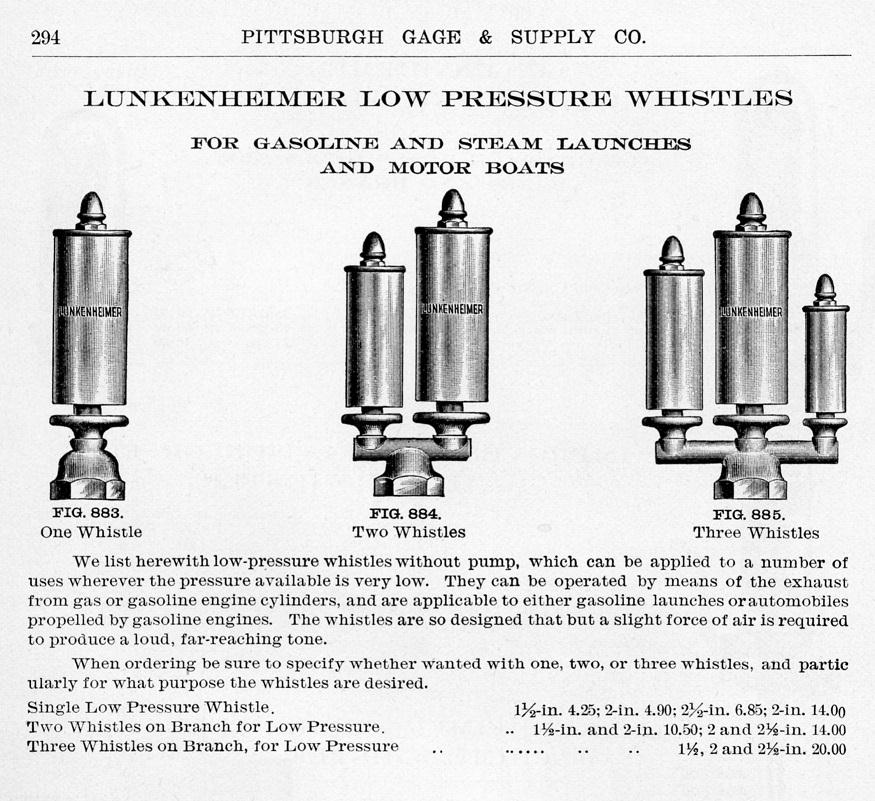
3 chime whistle in 1910 catalogue
Pittsburgh Gauge & Supply Co. catalogue from 1910 featuring a LUNKENHEIMER LOW PRESSURE
THREE CHIME WHISTLE (the whistle of choice for most Western River steamboats).
Founded by Fredrick Lukenheimer in 1862 as the Cincinnati Brass Works housed in a three story brick building which bore the name BRASS FOUNDRY. After Frederick's son Edmund joined the business, the name of the company was changed to the Lunkenheimer Valve Co. and continued to manufacture in Cincinnati, Ohio until June, 1968 when Condec (abbreviation of Concrete Decking) bought out its shareholders in a hostile takeover. In 1984, the company was bought by Dr. Bernard de Silva and three partners.
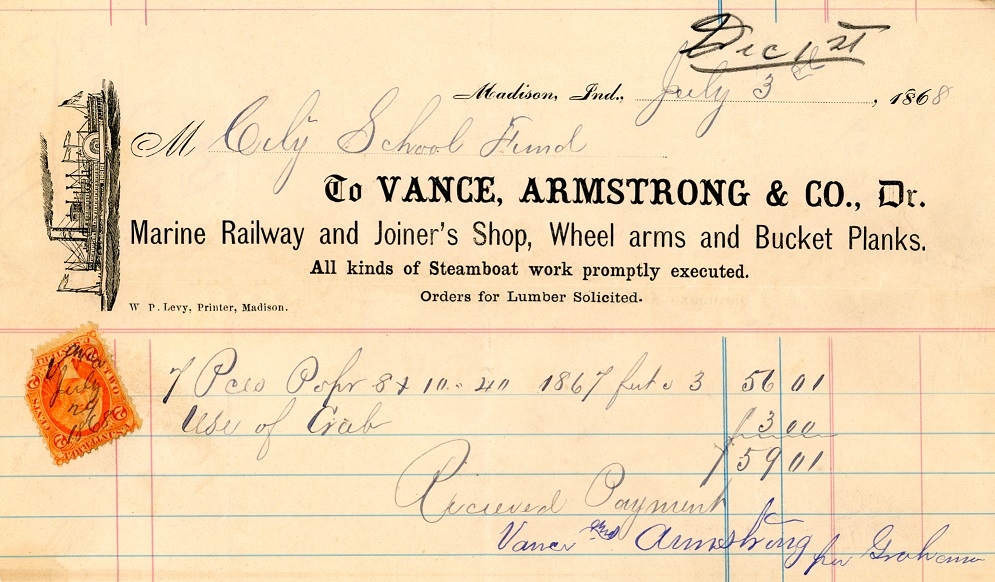
"All kinds of Steamboat work promptly executed" Madison, Indiana July 3rd/Dec1st1869
Madison, Indiana
Vance, Armstrong & Co.
"All kinds of Steamboat work promptly executed"
They specialized in parts needed for construction of paddlewheels:
Wheel arms and Bucket Planks.
Receipt for work completed for the City School Fund
July 3rd/Dec1st 1869
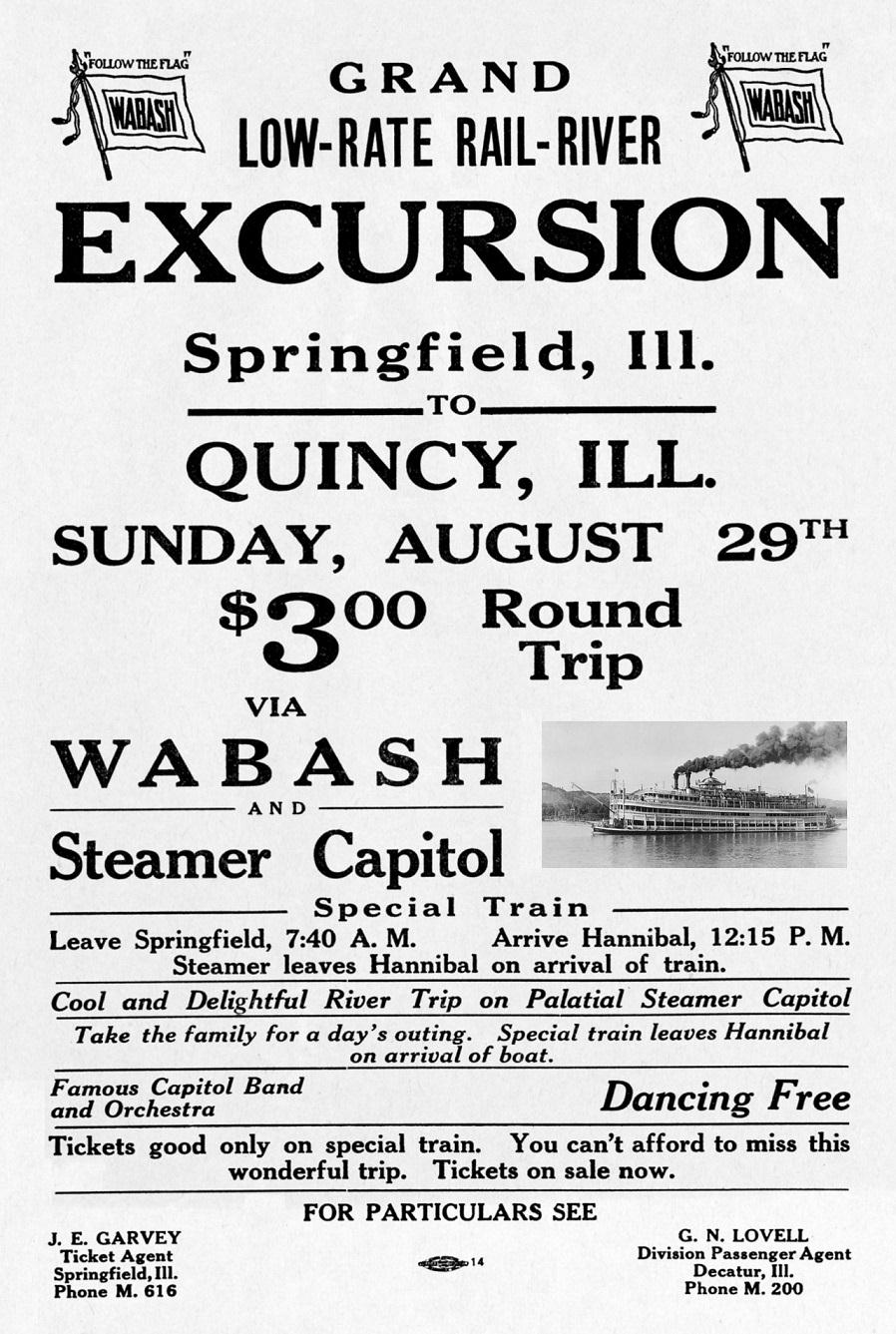 tion
tion
1920 EXCURSION aboard the steamboat CAPITOL from Hannibal, MO to Quincy, Illinois via rail from Springfield, Illinois
Broadside advertising an Excursion aboard the steamboat CAPITOL
Grand Low-Rate Rail-River EXCURSION
Springfield, Illinois to Quincy, Illinois
Sunday, August 29th, 1920 (?)
$3.00 Round Trip
via Wabash Railroad and Steamer CAPITOL
Leave Springfield, 7:40 A.M.
Arrive Hannibal, MO, 12:15 P.M.
Steamer leaves Hannibal upon arrival of train
Famous Capitol Orchestra Dancing Free
Ticket good only on special train.
You can't afford to miss this wonderful trip.
Tickets on sale now.
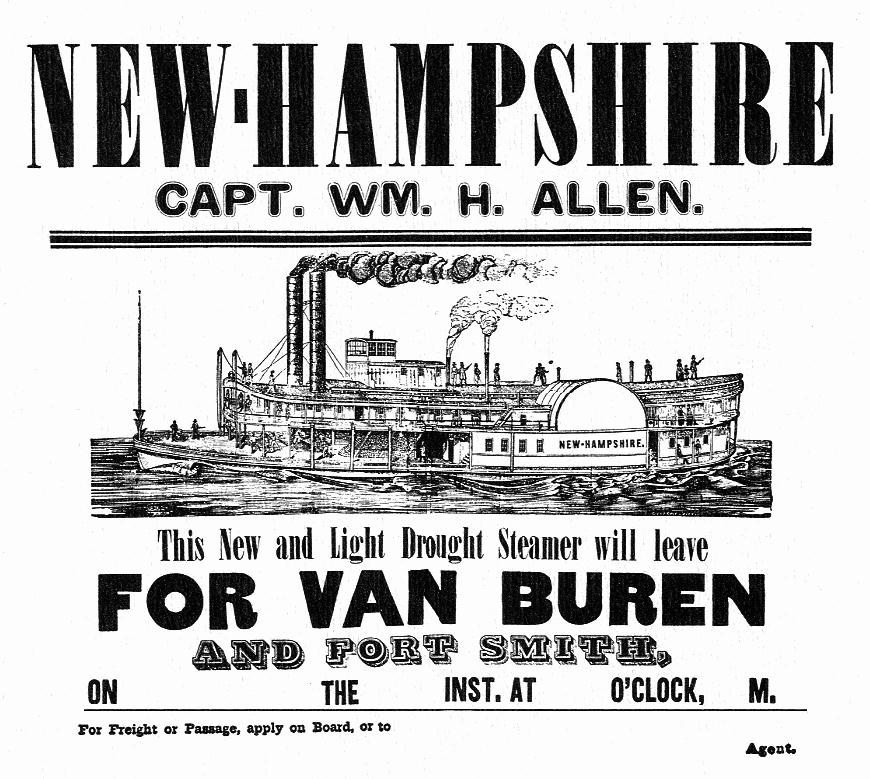
Broadside for the steamer NEW HAMPSHIRE for Arkansas River commerce
Broadside circa the 1840's and 50's.
Fred Way did not list the steamboat NEW HAMPSHIRE in his Packets Directory and no other references to the boat have been found.
The Arkansas destinations Van Buren and Fort Smith were on the Arkansas River.
Wikipedia
Van Buren, Arakansas is located directly northeast of Fort Smith. The city was incorporated in 1845
The area was settled by David Boyd and Thomas Martin in 1818.
After Arkansas became a territory in 1819 Daniel and Thomas Phillips constructed a lumber yard in the community to serve as a fuel depot for traffic along the Arkansas River.
In 1831 a post office was constructed for the community, at the time known as Phillips Landing.
This post office was named after the newly appointed Secretary of State Martin Van Buren.
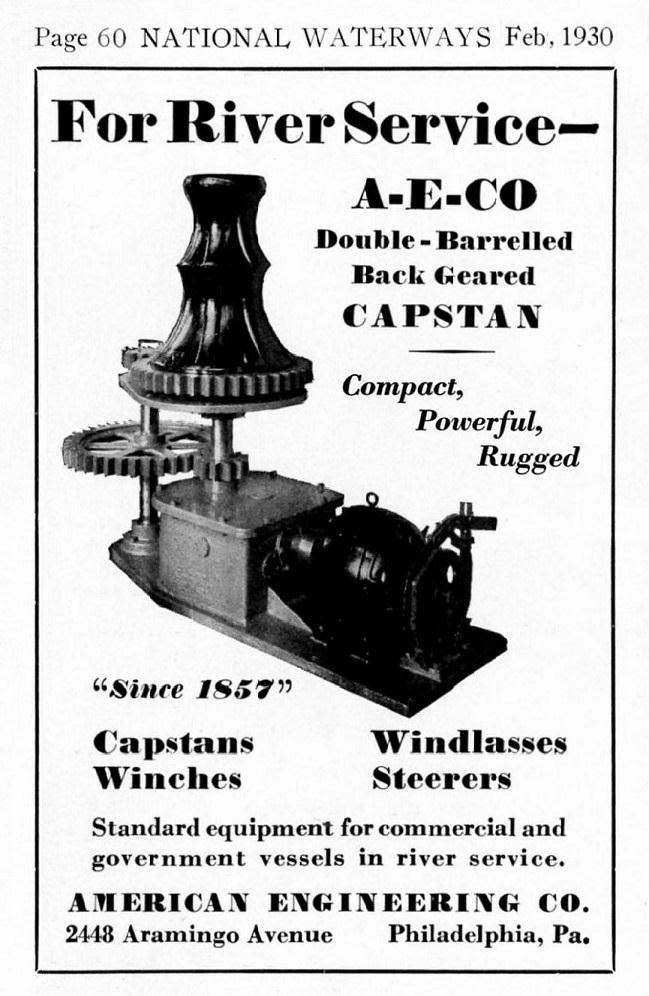
CAPSTANS "For River Services" ad in 1930 Nat'l Waterways
Capstan
Written by The Editors of The Encyclopaedia Britannica
This article was most recently revised and updated by Amy Tikkanen, Corrections Manager
A Capstan is a mechanical device used chiefly on board ships or in shipyards for moving heavy weights by means of ropes, cables, or chains. Capstans also have been used in railroad yards for spotting (positioning) freight cars. A capstan consists of a drum, driven either manually or by steam or electricity, that rotates about a vertical axis to wind in a line (rope, cable, or chain) that has been wrapped around it (see illustration). The grip between the line and the drum depends on friction and on the number of times the line is wrapped around the drum. Speed of drawing in the load can be controlled by allowing partial slippage of the line around the capstan. A notched track (ratchet) on the base plate and pawls attached to the drum prevent backward rotation.
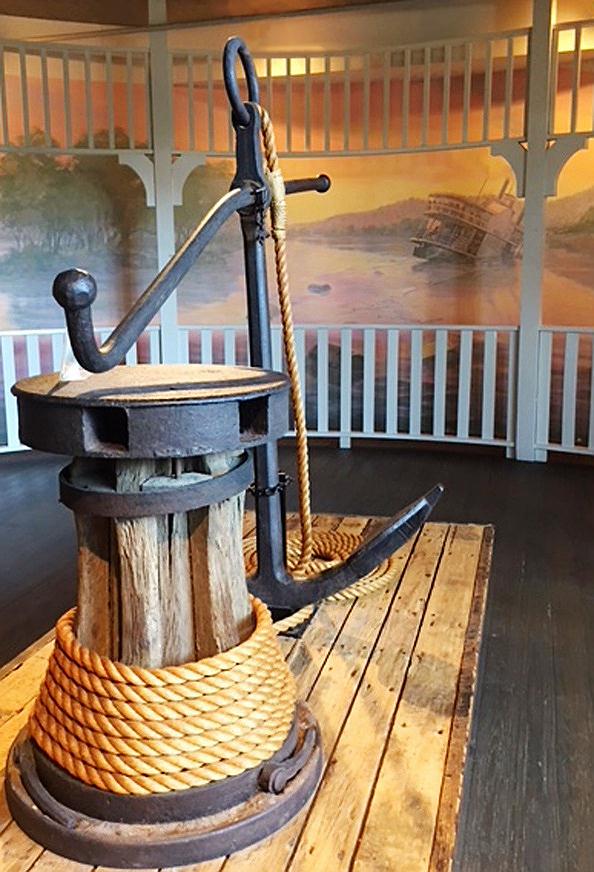
Steamboat ARABIA capstan and anchor from the Kansas City UNION BULLETIN newspaper
Photo taken in the Kansas City museum of artifacts from the steamboat ARABIA. Here is the ARABIA's capstan and anchor and through the "boiler deck" promenade can be seen one of the murals of the ARABIA after she had sunk on the Missouri River in 1856 that I photographed in the 1990's. This file belongs with my photos of this mural and another of the ARABIA while she was still afloat. The capstan and anchor photo came from the Kansas City UNION BULLETIN newspaper.
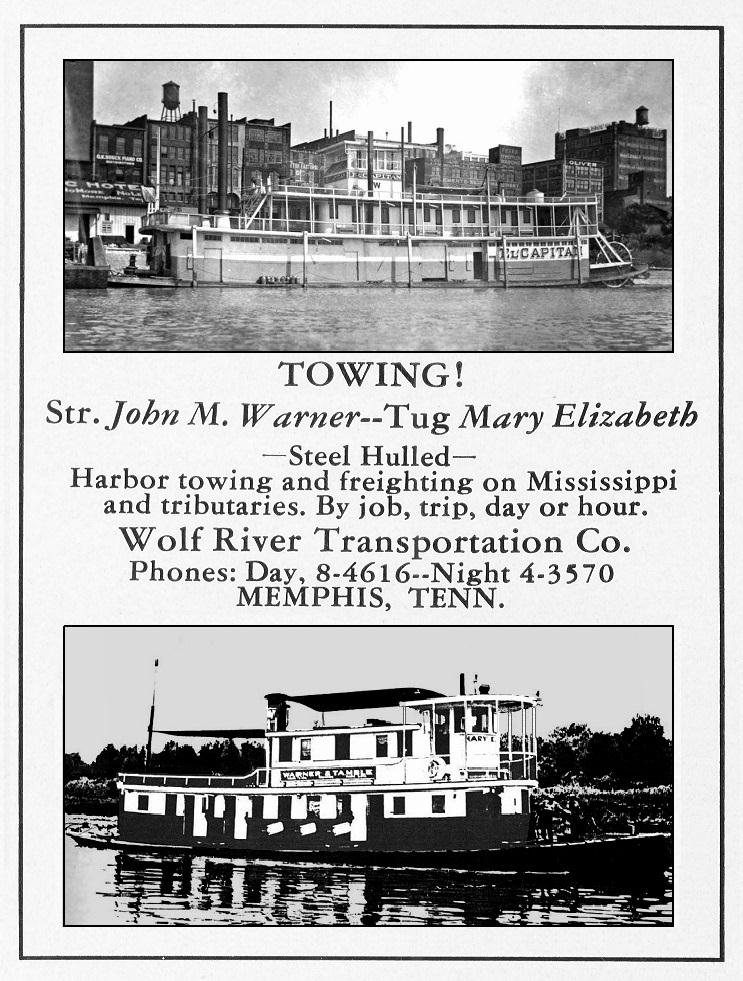
The original "Proud Mary" was the MARY ELIZABETH at Memphis
From the February 1932 NATIONAL WATERWAYS monthly on page 44 an ad for Wolf River Transportation's boats, the towboat JOHN M. WARNER (previously named the EL CAPITAN) and the tug boat MARY ELIZABETH that provided the inspiration for the popular song PROUD MARY.
The photos in the original ad were heavily screened and murky so I replaced them with a La Crosse photo of the EL CAPITAN (that was renamed JOHN M. WARNER when then Wolf River Transportation bought her 2 years prior to this advertisement) and the photo of the MARY ELIZABETH came from Jimmy Ogle's article (below).
JOHN M. WARNER
Sternwheel towboat circa 1930 - 1937
Way's Steam Towboat Directory Number T1420
Originally the EL CAPITAN built in St. Louis in 1903.
109.6 x 26 x 3.5. Engines 12's - 6 1/2 foot stroke.
Renamed when bought by Wolf River Transportaion Co. of Memphis, Tennessee about 1930. They sold her to the Tennessee Valley Authoriy by 1937 and she was then renamed HIWASSEE, later NORMAN CRAWFORD.
PROUD MARY: The story of the MARY ELIZABETH from JIMMY OGLE'S site:
jimmyogle.com
The MARY ELIZABETH was once referred to as the "Queen Mother of Memphis Towboats" for her service in the Memphis Harbor during the middle of the 20th century. Here's how the story unfolds:
The boat that became the inspiration for the "Proud Mary" was built in 1905 for the Lower Hudson Steamboat Company of New York. Originally named the SARAH A. JENKS A. Jenks and later, the OSSINING, she was used to transport convicted prisoners from New York City jails, up the Hudson River to the infamous Sing-Sing State Prison in Ossining, New York - thus explaining the true origin of the expression, "up the river"!
She was moved south in 1911, after being sold to the St. Tammany Steamship Company of Covington, Louisiana. The OSSINING spent the next four years being operated as a Ferry Boat over the 630 square mile Lake Ponchartrain.
In 1915 she was sold to Lyon Bros. of Greenville, Mississippi and used to run U.S. Mail from Greenville, upriver to Luna Landing, Arkansas. During this time, she was also converted from steam power to diesel power, which gave the OSSINING the distinction of being the first diesel power Ferry Boat on the Mississippi River.
After a dozen years, she was sold in 1928 to Warner & Tamble Inc. of Memphis, Tennessee. At this time she was refitted and remodeled into a Tow Boat, and rechristened to it's more familiar name, the MARY ELIZABETH, in honor of a family member of the new Memphis owner.
During her decades of service in Memphis, the MARY ELIZABETH was responsible for numerous duties. When the Harrahan Bridge burned in 1928, blocking all vehicle traffic for months until the roadway could be replaced, it was the Mary Elizabeth that ferried all commerce across the Mississippi River to Arkansas. She also transported over 3,000 head of cattle to river islands during the Dust Bowl era drought of 1934; performed salvage and rescue work during the big flood on the Wolf River in 1935; and worked throughout the area in rescue and levee work during the great flood of 1937. In 1939, she installed the first radio-telephone communication lines along the Wolf River and the Memphis Harbor. At this time, she also became the first Tow Boat on the Mississippi River to be equipped with a ship-to-shore radio.
In 1973, the MARY ELIZABETH was sold to Murphy Marine Service Inc. of Memphis. Murphy Marine ran her for a total of five years and then pulled her out of service.
1979 was to be the hardest year for the MARY ELIZABETH. Sold to a scrap dealer, George Perkins of Memphis, the MARY ELIZABETH was destined to be stripped and gutted. She had the first and second deck mid-ship house (The main superstructure located at the center of the ship.) removed and her engine pulled out. She was then stripped of all equipment, towed away and beached off the Lossahatchie River just above Memphis - only to rust from the merciless beating by the weather over the following seven years.
Hope of resurrection came in 1986 when the MARY ELIZABETH was sold to Proud Mary Restoration Inc. The hope grew as the first signs of restoration were seen in January, 1987. However, it was not to be. In 1988, during the all-time low of the river gage in Memphis (-10.7 in the second week of July), the MARY ELIZABETH began breaking up on the bank of the river and was hauled away for scrap.
During the 1960s, at the height of the Rock 'n' Roll era in Memphis, a deck hand on the MARY ELIZABETH wrote and composed a song he entitled, "Proud Mary" The song describes his feelings and experiences, his life and times aboard his ship, the MARY ELIZABETH. The song was published and recorded by John Fogerty of Creedance Clearwater Revival, and was also performed by other artists such as George Jones and Johnny Paycheck, Elvis Presley, Bruce Springsteen and pop diva, Tina Tuner. Tina Turner's upbeat rendition was more in the early 1980s style of music and entitled "Rollin' On The River". The tune has become one of the most popular and enduring songs of our age and has been placed #155 on Rolling Stone's 2004 list of The 500 Greatest Songs of All Time.
Many people that listen to the lyrics of the song, come away with the impression that the PROUD MARY was a steamboat pushed by sternwheel paddles - those "big wheel keep on turning . . ." Well I'm sorry, but you'd be wrong. In the riverboat vocabulary for tow boats, the word "wheel" often refers to the propellers under the boat that are turned by the engines. Another term is "screws" due to the propellers usually looking like oversized screws and while rotating to propel the vessel, they resemble a screw being turned. So in reality, the "big wheel that keep on turning" are under the tow boat, under water and out of sight, not the big paddlewheel seen behind a steamboat.
In 1993 my old friend, the late Capt. Jake Meanley (1948-2000) told me that in the 1970s when he was piloting ships for the MEMPHIS QUEEN LINE excursion company, he quite often used the MARY ELIZABETH through a lease agreement from Murphy Marine. She was used to push the MEMPHIS SHOWBOAT (barge) on countless moonlight river cruises. We can only guess at how many times that the bands were asked to play "Proud Mary."
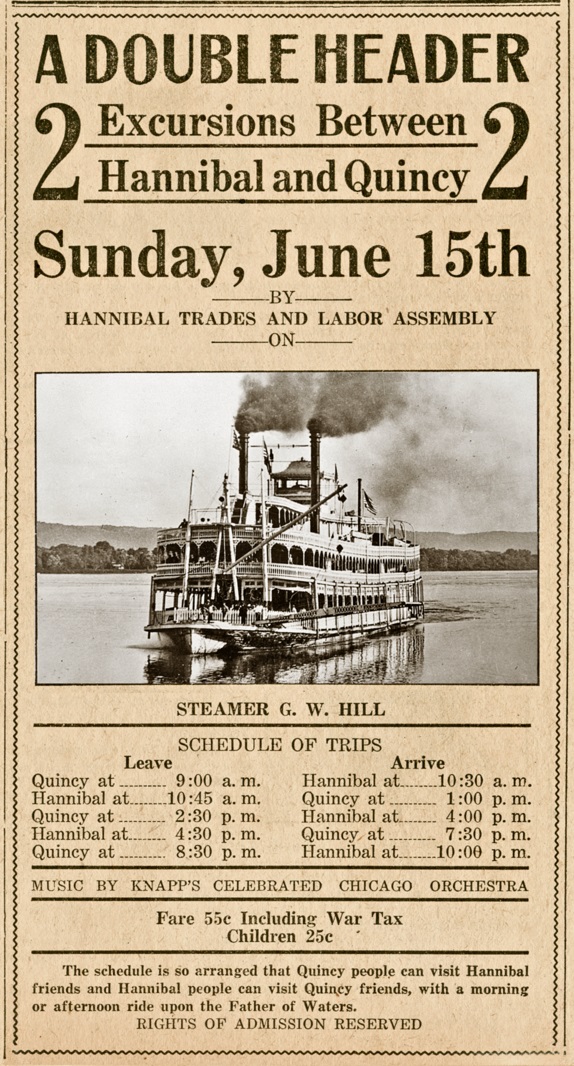
Ad in the Hannibal Labor Press for 2 cruises aboard the G.W. HILL on SUNDAY JUNE 15, 1919.
G.W. HILL
SternwheelPacket/Excursion boat
1909-1923
Way's Packet Directory Number 2188
Built in 1909 at Jeffersonville, Indiana by Howard Ship Yards for the St. Louis-Calhoun County apple trade. Named for Granderson Winfrey Hill of Alexandria, Missouri
Original price $28,850
Home port or owner's residence circa 1909, St. Louis, Missouri.
Owned by Captain D.W. Wisherd and Sam Gregory
Converted into an excursion boat in May 1912.
Captain Walter Wisherd (master, 1913)
Captain J.E. Short (pilot, 1913)
Captain Trim Wadlington (master, 1913)
Captain George L. White (master, 1914)
Edgar Wisherd (captain, 1916)
John Pierson (pilot, 1916)
Harry Wilcox (pilot, 1916)
After World War I she commenced tramping to the upper Ohio River, she also went to New Orleans, Pittsburgh, etc., until sold in 1923 after the steamboat fire at Cincinnati, Ohio (November 4, 1922) and renamed the ISLAND MAID.
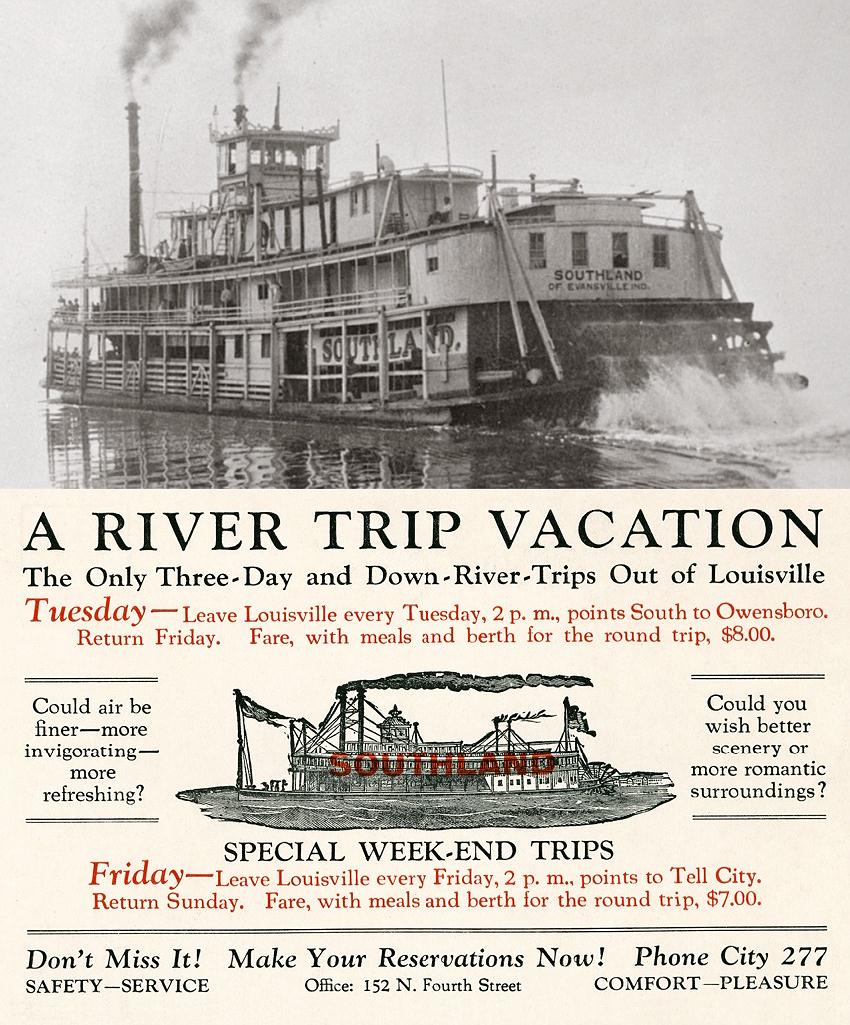
Broadside style advertising card with woodcut vignette of steamboat
Photo from the LaCrosse Collection
SOUTHLAND 1922-1932
Sternwheel Packet
Way's Packet Directory Number 5159
Built as the NASHVILLE in 1910 at Jeffersonville, Indiana by Howard Ship Yard
She was rebuilt from the NASHVILLE by the Williams Brothers at Paducah, Kentucky in 1922 and renamed SOUTHLAND
She ran Louisville-Stephensport-Evansville
Burned while laid up at Spottsville, Kentucky on December 16, 1932
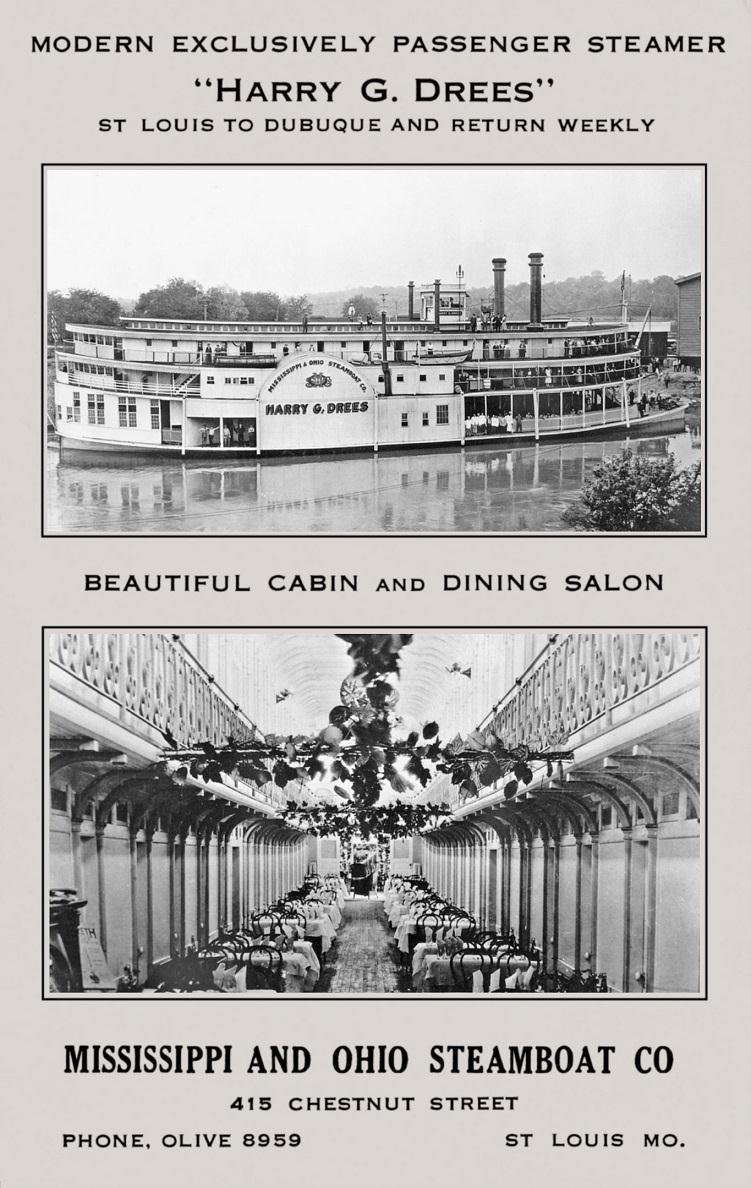
Promotional card excursion steamer HARRY G. DREES circa the 1920s
Attached fully restored promotional postcard that dates circa the 1920's. Lettering and outlines around pictures are now freshened up. Upgraded the photos that were on the original card of the starboard view of the boat and the cabin with far better quality ones from the La Crosse collection.
HARRY G. DREES
Sidewheel Excursion boat/Packet
Way's Packet Directory Number 2538
Built as the PILGRIM in 1917 at the Howard Ship Yards - Jeffersonville, Indiana. Remodeled into a tourist boat in 1924 by the Mississippi and Ohio Steamboat Company and renamed HARRY G. DREES after the new owner. Ben Winters was Captain during the mid-1920s. The DREES ran between St. Louis and St. Paul and often got stuck on sand bars due to her deep draft. She had 80 state rooms, shower baths, hot and cold water, toilets and electric lights. Was finally sold to Tampa, Florida where she gradually fell apart.
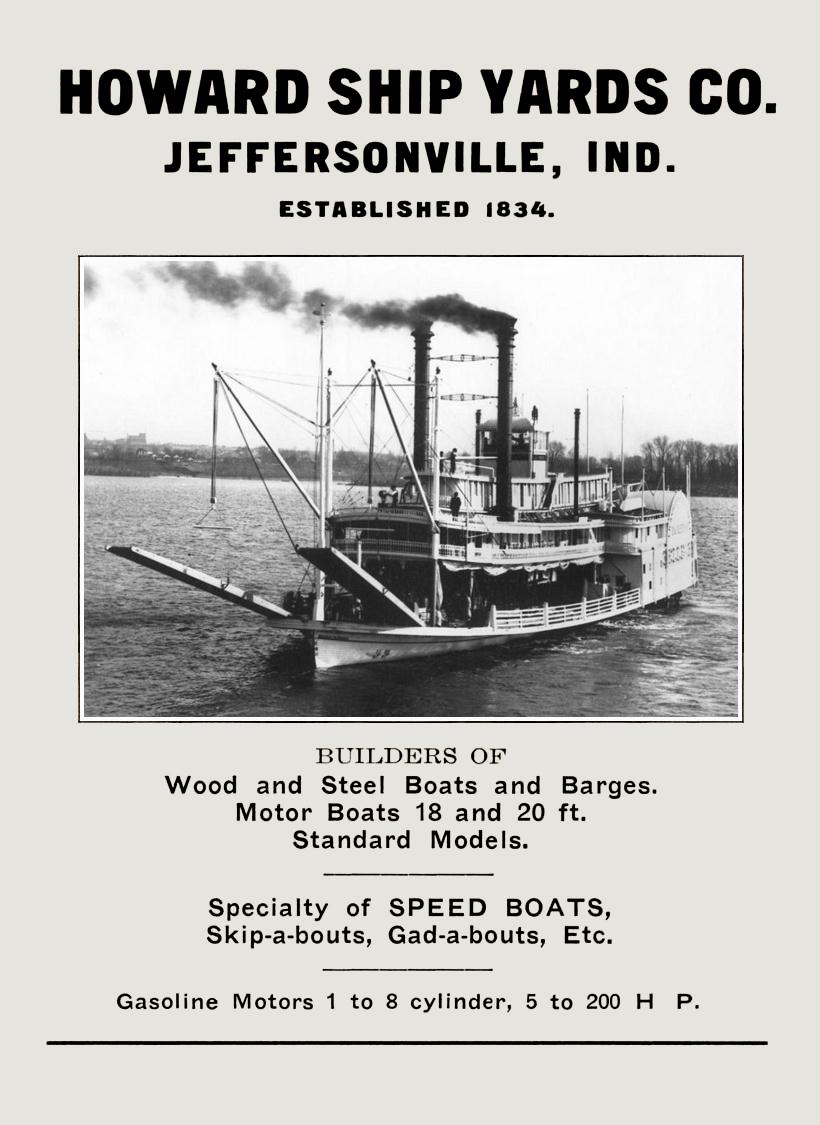
Advertising Card - Howard Steamboat Yards picturing the BELLE of the BENDS
Undated advertising card featuring the BELLE OF THE BENDS that was built at the Howard Steamboat Yards of Jeffersonville, Indiana in 1898.
BELLE OF THE BENDS
Sidewheel Packet
Way's Packet Directory Number 0531
Built in 1898 at Jeffersonville, Indiana by Howard Ship Yard for Vicksburg and Greenville Packet Company, J.J. Powers president and D.C.B. Robinson supervised construction, both of Vicksburg.
One of the more handsome of medium-sized sidewheelers; had all the Anchor Line grace, double stages and all. Ran Greenville-Vicksburg for many years--from 1899-1904 or later made twice weekly mail runs between those two cities for the packet company of that name. Was flagship of the parade celebrating the opening of the canal at Vicksburg when the Yazoo River mouth was diverted on January 17, 1903 --quite an occasion inasmuch as Vicksburg had virtually been cut off the river since Centennial Cut Off which happened April 26, 1876. Sank at Peeler's Landing, 40 miles above Vicksburg, September 1909, and was raised. Sank at Fitler's Landing, 20 miles below Lake Providence during a snowstorm in February 1910 and was raised. Another version states that she was caught in a heavy snowstorm while proceeding up the Mississippi River shortly after leaving Hayes Landing, Mississippi on February 10, 1910 and ran aground at full speed on a sand bar; estimated damage $10,000. Then operated by Captain Morrissy; ran excursions at New Orleans in the winter 1910-11. Used in the Nashville grain trade after 1904. Was converted into an excursion boat and renamed LIBERTY. In 1940 her roof bell was at the Altheimer Plantation near Pine Bluff, Arkansas. Original price $33,500; home port or owner's residence circa 1898 was Vicksburg, Mississippi
Owned by Vicksburg and Greenville Packet Company (1898); Mr. A.D. Frantz (circa 1910), St. Louis Excursion and Packet Company; H.S. Albrecht (1917)
Officers and Crew: Captain A.F. Nimtz (1900); Charlie Kain (clerk, 1901); Harry Bumgartner (clerk, 1901); Henry McFarland (clerk, 1901); Billy Newbill (pilot, 1901); Joe Delahunt (pilot, 1901); Mike O'Keefe (engineer, 1901); George Meir (engineer, 1901); James McGowan (steward, 1901); Captain Sam G. Smith (manager and purser, 1907); Captain Maurice Killeen (master, 1913); Captain Milt Henry (1914); Tom Parker (pilot, 1914); Captain George F. Carroll (master, 1914); Captain Frank Gill (master, May 1914); Captain Steve E. Greenwell (1915); Ed. Hellings (engineer, 1914-15); Captain Morrissy (1910) and J.O. Tayon (pilot)
howardsteamboatmuseum.org
The Howard Ship Yards in Jeffersonville, Indiana on the banks of the Ohio River were established in 1834 by nineteen-year-old James Howard who and began to build his first boat, the HYPERION.
Howard built steamboats included, the luxurious J.M. WHITE, the speedy CITY OF LOUISVILLE and the popular INDIANA.
Howard's beautiful 1894 mansion home was built by master craftsmen from the shipyard who created many of the details in the decor of the mansion.
The home is now the Howard Steamboat Museum and features original furnishings, brass chandeliers, stained glass windows, intricate carvings throughout and are featured in the grand staircase.
Models, photographs, paintings, half-hull models and other artifacts can also be enjoyed at this unique Jeffersonville museum. The Howard Steamboat Museum is open year round.
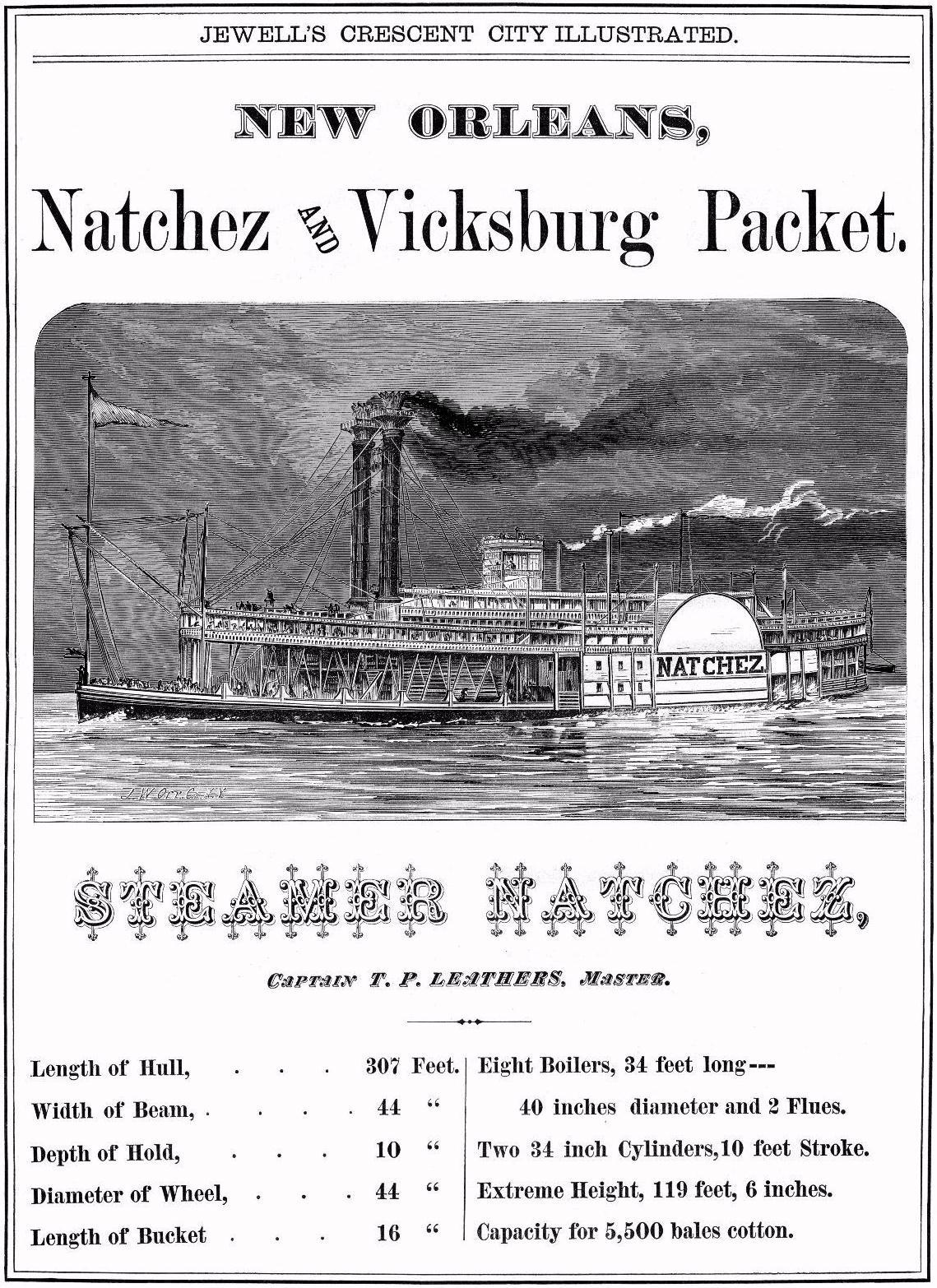
From JEWELL's CRESCENT CITY ILLUSTRATED a local New Orleans, a full page original advertisement for one of Cap'n Leathers' series of boats named NATCHEZ.
Jim Hale believes that this is probably the 6th boat by that name.
There was no date on this piece which was yellow with age. I cleaned it up in this hi con version.
The reduced scan produced a "moray pattern" in the sky which of course the original doesn't have.
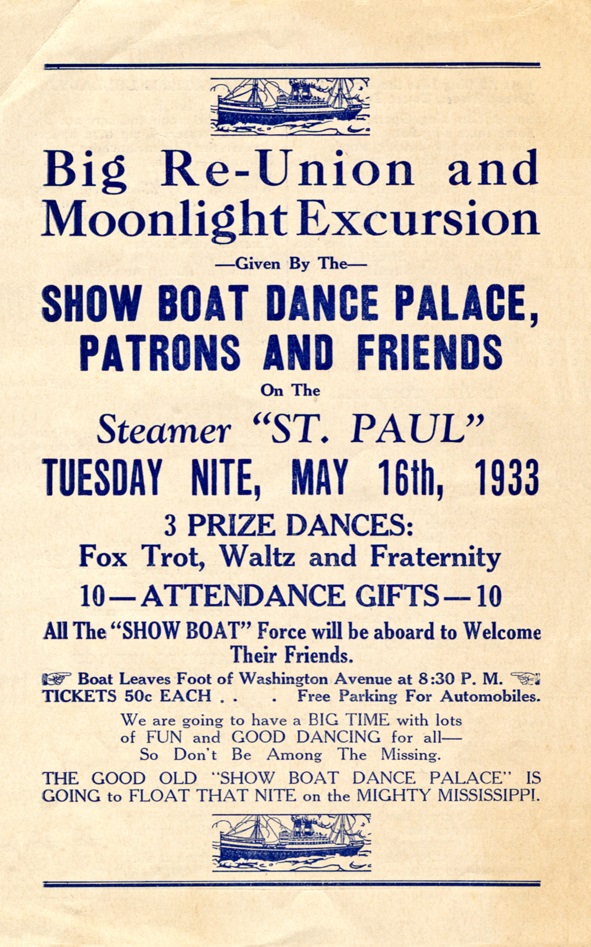
1933 flyer for an excursion aboard the ST. PAUL leaving from "the foot of Washington Avenue" (which flowed onto the Eads Bridge) across the Mississippi at St. Louis. The sponsor of the excursion was the"Show Boat Dance Palace" located on Iowa Avenue in St. Louis, was one of at least half a dozen "dance halls" in St. Louis during the 30's. On the top and bottom of this handbill the "job" printer used vignettes of an ocean-going ship rather than a steam riverboat which would have been more appropriate.
The ST. PAUL was built in 1883 at St. Louis, MO for the St.Louis & St. Paul Packet Co. and ran under the Diamond Jo flag. Also briefly chartered to the Anchor Line. Rebuilt in 1892 at the Eagle Yard in Dubuque, Iowa by Diamond Jo - then rebuilt again at Dubuque in 1903. She went to the Streckfus Line in 1911. In 1917, Streckfus rebuilt her into an excursion boat running in the St. Louis area. Rebuilt again at Paducah, KY in 1939 as the SENATOR. Retired from excursion service in 1942. Abandoned near St. Louis in 1953.
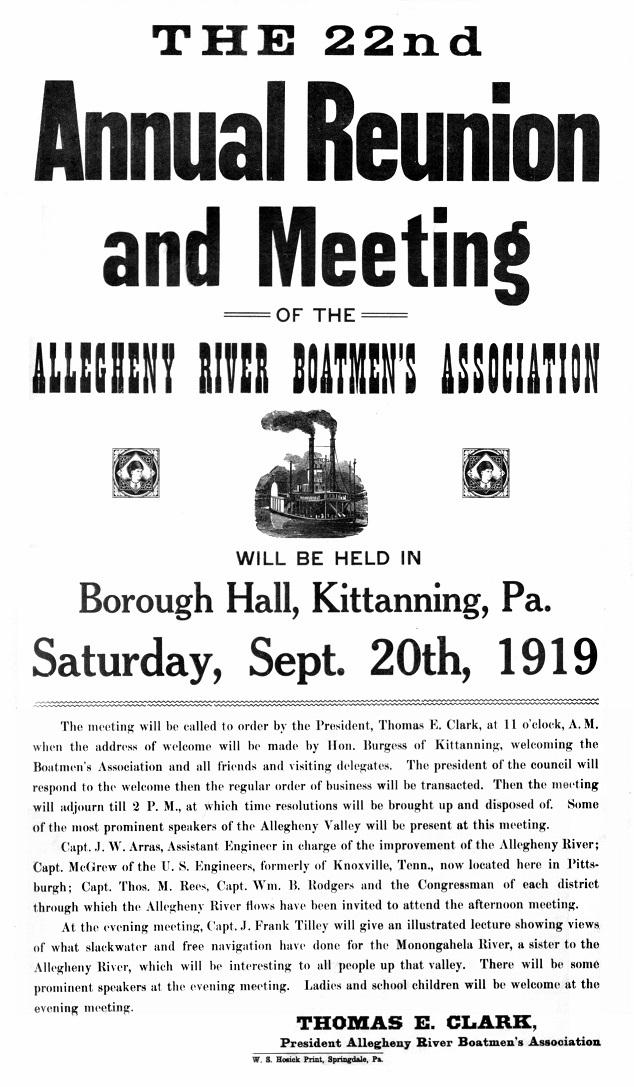
Another vintage broadside from my earliest days of collecting this material during the 1980's.
This broadside measures 11 X 18 inches announcing the last annual meeting in 1919 of the ALLEGHENY RIVER BOATMEN'S ASSOCIATION
at Kittaning, Pennsylvania on the Allegheny River around 40 miles northeast of Pittsburgh.
THE ALLEGHENY
by Frederick Way Jr.
Farrar & Rinehart, NY
1942
From the opening of CHAPTER 20
Captain Dan Fry was a little fellow who, if he were found under a Christmas tree, would pass for Santa Claus dressed up in store clothes.
Same twinkly eyes, ruddy cheeks, perky nose, beard and all. He showed up every year at the annual meeting of the Allegheny River Boatmen's Association and was the center of the scene.
He always was called upon to make a speech. Captain Fry would slowly get to his feet and take a good, long lingering look all around the hall until silence reigned supreme.
Then, in a quiet, almost unbearable voice, he would say, "Mr. Chairman of the meeting and my friends of the Allegheny River, the most noble stream in the world."
Another pause. Captain Fry's merry eyes roved around until he discovered a particular face in the audience which suited him.
Thereafter all remarks were directed to that individual. "I am not much of a speechmaker, but . . ." he said.
His story usually picked up a thread of the long and adventurous life he had spent keelboating and steamboating on his beloved river.
The homely little reunions of this Boatmen's Association started back in 1897 and met annually, without interruption, until 1919.
Each one had a new tinge of sadness, inasmuch as the members were growing old, and tragedy stalked in all eyes when a new arrival announced, "No, Jim can't get here today: he's down with rheumatism bad and can't make it."
To men who have lived a river life an inability to gather among old friends and rehearse the glories of a past yesteryear is worse than the inevitable visit of the Grim Reaper in person.
"Jim can't get down today." Real trouble, there. Heads would shake, canes would pound the sidewalk in mute appeal, and tears would come. "Jim can't get down, did you hear?"
A whole year has rolled around since any one of those veterans has seen Jim. No word, no sign. Christmas has come and gone without the exchange of a postcard greeting.
Yet Jim belongs at the meeting of the Boatmen's Association. Jim is one of the fellows.
Rivermen, as a group, are an odd lot in this respect: those bitter tears were springing from a knowledge of how Jim felt about it—laid up at home with that persecuting, damnable, inhuman failing of old age: rheumatism.
Each old-timer could see Jim sitting at a window looking out on the valley and aching his heart out to be at "the meeting."
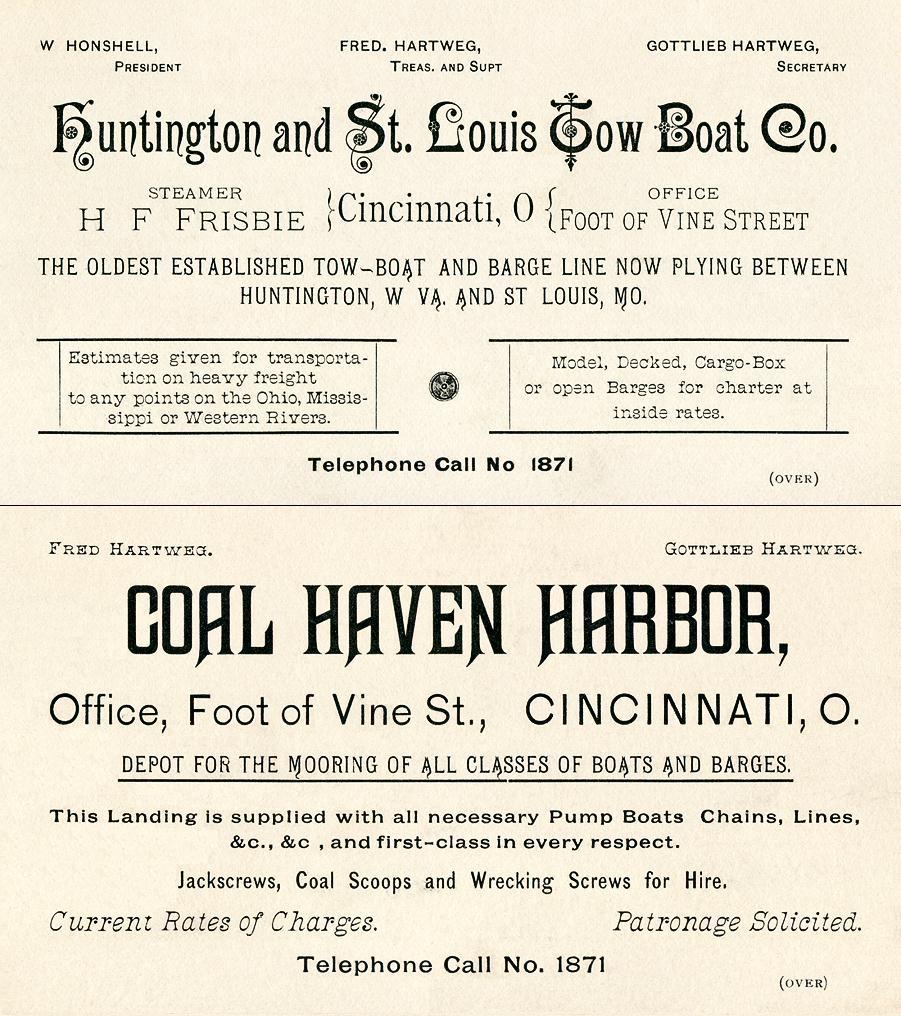
H. F. FRISBIE
Way's Steam Towboat Directory Number T1010
Sternwheel towboat 1885-1903 b Cincinnati, OH, 169.4 x 32.2 x 5.8
Engines 20's - 8 ft. stroke.
Owned by the Huntington & St. Louis Towboat Co. of which Fred Hartweg was president and treasurer, Gottlieb Hartweg, secretary, with offices maintained at the foot of Race Street, Cincinnati. When this undated 3 X 5 inch advertising card was printed the office was located at the foot of Vine Street. On the reverse of the card is the company's promotion of their other enterprise - Coal Haven Harbor for the mooring of "all classes of boats and barges."
The H & St. Lou Towboat Company also operated the towboat WASH HONSHELL.
Her skipper in 1888 was Capt. William Rutter of Clarington, Ohio and on one trip, just leaving Cincinnati with a big tow of coal, produce, etc., the tow struck the Kentucky pier of the Southern bridge, sinking two barges.
Capt. Rutter fell dead of heart failure as a result of the excitement. Capt. Rutter was then about 65 years old, a tragedy all the worse because his wife and two children were aboard making the trip south.
The FRISBIE made frequent trips to the upper Mississippi, towing cross ties to Burlington, Iowa.
Capt. Henry Nye and Capt. Henry C Pownall were masters on her.
"Buck" Nye was chief engineer for some time and Ernest P Cropper was 2nd, Noah and Sam Ellis were on her later.
The Combine bought her and towed her to Pittsburgh with the BOAZ in September, 1903, then dismantled her at Elizabeth, Pennsylvania.
Her machinery went to the SARAH EDENBORN.
H. F FRISBIE, for whom she was named, died in January, 1912.
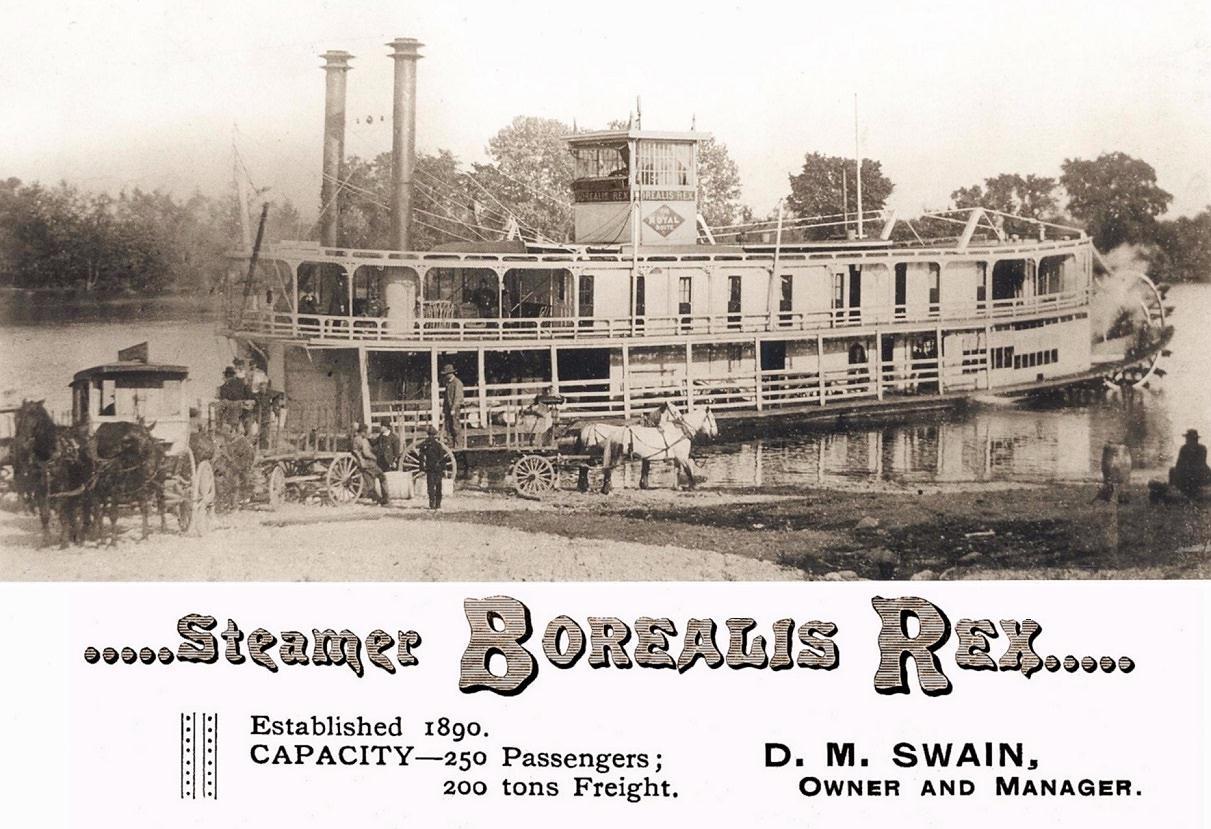
Borealis Rex Advertising Card
Carrie Stier (co-owner of the TWILIGHT) kindly shared the attached image of the BOREALIS REX
Sternwheel Packet
Way's Packet Directory Number 0680
Built at Stillwater, Minnesota in 1888
Owned by Captain David Swain, 1888; Captain George Prince, June 4, 1903; Captain Ben Moss and A.B. McCain, 1905; Lake Charles and Cameron Transportation Company
Officers:
In 1888, Captain David Swain; Samuel C. Gulick (master) Nov. 27, 1895; Captain Charles Ebaugh; 1903, Captain George Prince
Ran on the Illinois; Mississippi; Black; Ouachita; Tensas; Little and Atchafalaya rivers
Operated around Stillwater, Minnesota until 1890 when she was brought to the Peoria-La Salle trade on the Illinois River under command of Captain Charles Ebaugh. 1903, Captain George Prince ran her out of Natchez twice weekly.
One trip to Atchafalya, the other to the Black, Ouachita, Tensas and Little rivers.
Several years later she was sent to Lake Charles, Louisiana, but a modern highway ended her trade.
Moored for a time at the foot of Pugo Street in St. Charles, Louisiana, and idled until sold for junk in 1938 for only $110.
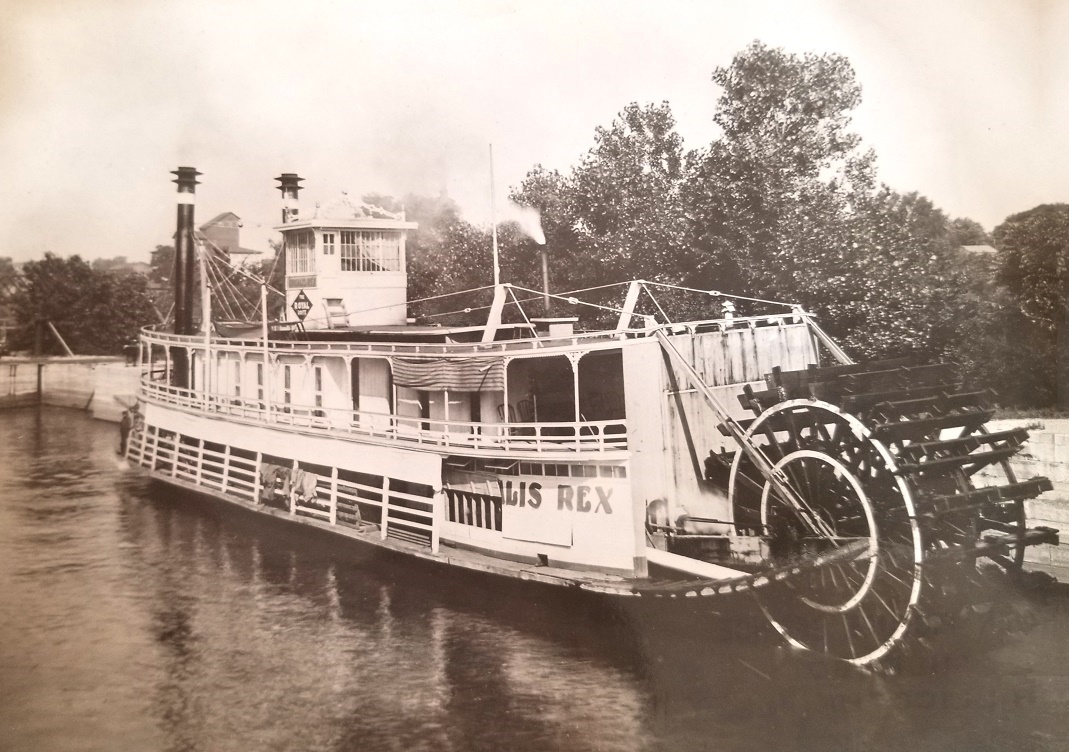
BOREALIS REX.

With the exception of images credited to public institutions,
everything on this page is from a private collection.
Please contact Steamboats.com for permission for commercial use.*
All captions provided by Dave Thomson, Steamboats.com primary contributor and historian.
